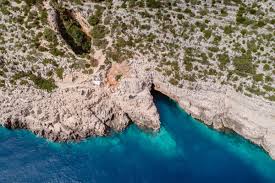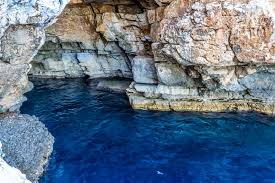Mljet Island — Mythical Ogygia Island, or Croatia’s Ancient Marine Sanctuary
- Teo Drinkovic
- Oct 16
- 4 min read
Could this lush Adriatic island of Mljet be the home of the nymph Calypso and the true prison of Hero Odysseus’ seven-year exile?
Odysseus, in ancient Greek war gear, standing before the nymph Calypso on the island of Mljet, in front of the entrance to the cave

Introduction
Nestled in southern Croatia, in the mesmerizing blue waters of the Adriatic, lies the island of Mljet, often referred to as the “Green Island” for its dense pine and oak forests. Olive groves and vineyards also stretch across its terrain, making Mljet known not just for its wild beauty, but also for its high-quality olive oil and wine.
Thanks to its extraordinary natural wealth, Mljet was granted protected status on 11 November 1960 when the Mljet National Park was founded. It is recognized as the oldest marine protected area in the entire Mediterranean, covering nearly 5,300 hectares, which includes a marine belt extending 500 meters from the coastline, roughly one-third of the island’s total area. np-mljet.hr
Legend whispers that this very island was Ogygia, home to the nymph Calypso, where Odysseus was shipwrecked and held captive for seven years.
Geographic Position of Mljet
Mljet belongs to Dubrovnik-Neretva County in southern Croatia, among the southern Dalmatian islands. Its land area spans about 100.4 km², while its coastline stretches roughly 164.9 km.
The island is oriented northwest to southeast, running parallel to the eastern half of the Pelješac peninsula, from which it is separated by the Mljet Channel (about 8 km wide).
The northwestern section of Mljet was designated National Park territory, and the marine buffer zone in parts extends 500 meters seaward from the coast, enforcing protection over the adjacent seas. Parkovi Hrvatske
Mljet Island National Park
Source: Google.com
A Brief History of Mljet
Mljet’s story is built in layers. Before the Romans, Illyrian tribes inhabited the land. Under Roman rule, the island held strategic importance thanks to its natural harbors — remains of a grand palace can be found in Polače today. Unforgettable Croatia
Through the Middle Ages, Mljet came under Byzantine influence, the realm of the Republic of Ragusa (Dubrovnik), and monastic orders (notably the Benedictines). An iconic remnant is the Benedictine monastery on the islet of Sveta Marija (St. Mary) in the Great Lake (Veliko jezero).
Settlements expanded gradually. Okuklje dates from the 15th century, Korita is documented from 1474, and Maranovići bears traces of Spanish / Sephardic influences. Babino Polje remains the largest inland village to this day. In the 20th century, tourism became a major economic force, turning the island’s infrastructure and local services toward hospitality, while striving to preserve its ecological integrity.
The Myth of Odysseus and Calypso
In Homer’s Odyssey, Odysseus, after the fall of Troy and years of wandering, lands on Ogygia, where the nymph Calypso detains him for seven years. She offers him immortality if he stays, but his heart yearns for home (Ithaca). At Zeus’s behest, Calypso finally lets him depart.
Ogygia is described as a place of lush gardens, water, forest, olive groves, vineyards, and a cavern where Calypso resides. Many local legends and tourist sources claim Mljet is that Ogygia. A key piece of evidence is Odysseus’ Cave (Odysseus’ Cave / Odisejeva špilja) near Babino Polje, featuring a sea tunnel, deep waters, rocky surroundings, and a dramatic entrance, all resonant with elements of Homeric description.
This cave has a tunnel of about 20 meters, with water depths between 8 and 10 meters. The sea-level entrance sits only 1 to 1.5 meters above the sea surface, making the approach dramatic.
Locally, “Babino Polje” (literally “old woman’s / grandmother’s field”) might subtly evoke Calypso’s rule; in folk interpretation, she becomes “baba” (grandmother or matron) of the island. Tour guides and promotional texts often call Mljet the “Island of Odysseus” or “Island of Ogygia,” with the cave as the locus of his mythical exile.
However, the identification is speculative. The original Ogygia has also been proposed at Gozo (Malta), among other Mediterranean locations.
Odysseus' Cave on the island of Mljet, Croatia, where, according to legend, the nymph Calypso lived and captured Odysseus for 7 years
Source: Google.com
Natural Beauty, National Park, and Highlights
Inside the National Park, the Great Lake (Veliko jezero) and Small Lake (Malo jezero) stand out, joined by a narrow channel to the sea. The forested surroundings and tranquil waters are the principal reasons the area was protected.
On the Great Lake lies the islet Sveta Marija, home to the 12th-century Benedictine monastery, a picturesque and much-photographed landmark. mljettravel.com
A network of hiking and walking trails is well-developed. The “Olive Trail” climbs from Babino Polje toward Odysseus’ Cave, passing through olive groves and vineyards. Trails circumnavigate the lakes and link villages such as Polače and Pomena, offering stunning views and access to sacred and cultural sites.
Villages of Mljet and What to See
Polače: Gateway to the National Park, harbor for excursions, and site of Roman-era palace ruins.
Pomena: Once a fishing village, now a tourism hub with the hotel “Odisej,” access to lakes, and a departure point for excursions.
Sobra: The island’s transportation hub with ferry and boat links, restaurants, and lodging.
Babino Polje: Largest inland settlement, local life, restaurants, and a trailhead to Odysseus’ Cave.
Okuklje and Maranovići: Quaint, peaceful hamlets by the sea, prized for their serene character and traditional feel.
Polače, Sobra, and Babino Polje on the Mljet island
Source: Google.com
Gastronomy & Wine
The food on Mljet is shaped by the sea and the land. Expect fresh fish, octopus, shellfish, dishes “under peka” (slow-roasted under a lid), all enriched with local olive oil and Mediterranean herbs. Beehive honey, dairy produce, rakija (fruit brandy), and homemade liqueurs round out the table.
Wine is a central tradition. Autochthonous local varieties include Kuljenača, Mrkuša, Kuča, and Dilipera (Mljetska). Wine and liqueur tastings and competitions are common, showing that viticulture is more than folklore; it’s alive and valued.
Restaurants like Mali Raj serve local seafood, lobster, grilled meats, desserts, and wine. Restaurant Melita, under the monastery roof by the Great Lake, offers Dalmatian cuisine in a tranquil, scenic setting.
Night Life on Mljet
Mljet is not a party island. There are no giant nightclubs or pumping dance venues. Evenings tend toward laid-back dinners by the water, casual drinks on seaside terraces, and occasional live music in summer.
In Pomena and Sobra, you’ll find bars and cafés. On quieter nights, a gentle sunset drink, a dance to soft local melodies, and the hush of the island make for the best kind of nighttime.





















Feel free to comment!